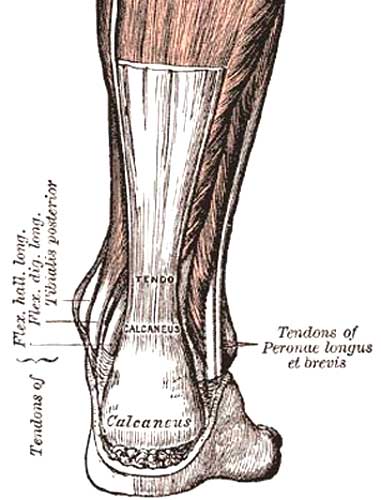.

Posterior view of the foot and leg, showing the Achilles tendon (tendo calcaneus). The gastrocnemius muscle is cut to expose the soleus.
The Achilles tendon (or occasionally Achilles' tendon), (tendo Achillis) or the calcaneal tendon (tendo calcaneus) is a tendon of the posterior leg. It serves to attach the gastrocnemius (calf) and soleus muscles to the calcaneus (heel) bone.
Anatomy
In humans, the tendon passes behind the ankle. It is the thickest and strongest tendon in the body. It is about 15 cm long, and begins near the middle of the leg, but receives fleshy fibers on its anterior surface, almost to its lower end. Gradually becoming contracted below, it is inserted into the middle part of the posterior surface of the calcaneus, a bursa being interposed between the tendon and the upper part of this surface. The tendon spreads out somewhat at its lower end, so that its narrowest part is about 4 cm. above its insertion. It is covered by the fascia and the integument, and stands out prominently behind the bone; the gap is filled up with areolar and adipose tissue. Along its lateral side, but superficial to it, is the small saphenous vein.
Nomenclature
The oldest-known written record of the tendon being named for Achilles is in 1693 by the Flemish/Dutch anatomist Philip Verheyen. In his widely used text Corporis Humani Anatomia, Chapter XV, page 328, he described the tendon's location and said that it was commonly called "the cord of Achilles" ("quae vulgo dicitur chorda Achillis").
The most direct connection is in the Iliad, Book XXII, where it is not in Achilles that that part of the body is mentioned. Rather, he cuts into the body of his slain enemy Hector near the feet, lashes them together with ox-hide, and drags his body behind his chariot, suggesting Achilles making use of Hector's calcaneal tendons. One translation (by Walter Leaf) reads
The tendons of both feet behind [Achilles] slit from heel to ankle-joint, and thrust there through thongs of ox-hide, and bound him to his chariot, leaving [Hector's] head to trail.
Homer's later, separate, account of the fatal wound to Achilles' heel is also sometimes connected to the term "Achilles tendon"; the painfulness of blows to it, and the crippling effect of its severing offer some plausibility to such ideas.
Role in disease
Achilles tendinitis is inflammation of the tendon, generally due to overuse of the affected limb or as part of a strain injury. Achilles tendon rupture is a partial or complete break in the tendon; it requires immobilisation or surgery. Xanthoma can develop in the Achilles tendon in patients with familial hypercholesterolemia.
Treatment of Achilles tendon damage
Initial treatment of damage to the tendon is generally nonoperative. Orthotics can produce early relief to the tendon by the correction of malalignments, non-steroidal anti-inflammatory drugs (NSAIDs) are also known to be effective.
Where tendon rupture is concerned, there are three main types of treatment: the open and the percutaneous operative methods, and nonoperative approaches.
Achilles tendon damage in popular culture
Severance of the Achilles tendon is considered by many a particularly unpleasant injury. This has led authors to use it for shock value. Achilles tendons are severed in the horror movies Pet Semetary (1989) and Hostel (2005), and in Kill Bill (2003). The respecting scenes are considered to be the most disturbing ones by some viewers (ref: Forum entires on IMDB). In the Gor novels, severing Achilles tendons is a punishment for slaves who try to flee.
Links
Achilles Tendon Repair
| Ancient Greece
Science, Technology , Medicine , Warfare, , Biographies , Life , Cities/Places/Maps , Arts , Literature , Philosophy ,Olympics, Mythology , History , Images Medieval Greece / Byzantine Empire Science, Technology, Arts, , Warfare , Literature, Biographies, Icons, History Modern Greece Cities, Islands, Regions, Fauna/Flora ,Biographies , History , Warfare, Science/Technology, Literature, Music , Arts , Film/Actors , Sport , Fashion --- |
Retrieved from "http://en.wikipedia.org/"
All text is available under the terms of the GNU Free Documentation License

